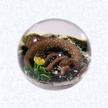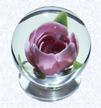Lampwork Technique

Lampworked Red Rose
Baccarat, circa 1845-55Lampwork Technique
A large group of paperweights in the Barker Collection required the work of an artisan skilled with the torch or blow-lamp. This third major technique of paperweightmaking, called lampwork, involved fashioning bits of colored glass from rods into specific shapes that were ultimately combined into fruit, vegetables, flowers, reptiles, and insects.
The Lampworking Process
A group of lampwork parts were called "set-ups". Delicacy and precision were required of the skilled artisan when lampworking flora and fauna for paperweights. Lampworking was a common technique, acquired and practiced by glass artisans in the production of articles that predated paperweights. Many fine examples of early lampwork are seen in sixteenth- and seventeenth-century Venetian glass in such objects as covered sheer goblets with glass threads coaxed into winged serpents with coiled bodies.
< >

Lampworked salamander
Attributed to Pantin
Late nineteenth centuryWhen applied to paperweight designs, lampworking resulted in remarkably realistic creation. Examples of this highly creative skill are found in a great many paperweights in the Barker Collection: the superb magnum Pantin salamander, resplendently colorful snakes, a dainty butterfly over a red and white blossom, and fruit weights such as the luscious strawberry. Individual lampworked flower set-ups were carefully made, petal by petal and leaf by leaf. Flat bouquets and three-dimensional upright crimped bouquets required the skill of extremely talented glassmakers. Two Clichy flower weights in the collection exhibit imaginative lampwork on split lengths of millefiori canes creating beautiful flower petals (morning glory and pink flower).
Millville Roses
The Barker Collection has four examples of an American lampwork design that is known as a Millville Rose. Millville, New Jersey was the home of the Whitall & Tatum Company, which made utilitarian glassware. An employee there, name Ralph Barber, is credited with making the first rose in 1905. A rose consists of a lifelike rose blossom and leaves floating in a clear paperweight above its base. The construction involves the use of a brass tool called a crimp that is shaped like a rose. A layer of colored glass is added to the end of a clear gather. The crimp is pushed into the gather, forming petals of color that extend up through the clear section, forming a rose. The galssworker removes the crimp, closes the bottom end of the petals together, and more clear glass is added so the rose appears to float.

Larson Rose
Emil Larson, at various times employed by Dorflinger, Pairpoint, and H. P. Sinclair, worked at home in Vineland, New Jersey, to make about 100 roses, starting in 1934. The one in the Barker Collection sports shaded petals, which was a trademark of BarberÕs roses. The Collection also contains a rose made in the 1950s by Charles Kaziun of Brockton, Massachusetts, and an imported one from China, where American dealers ordered them from about 1930 to 1938.










